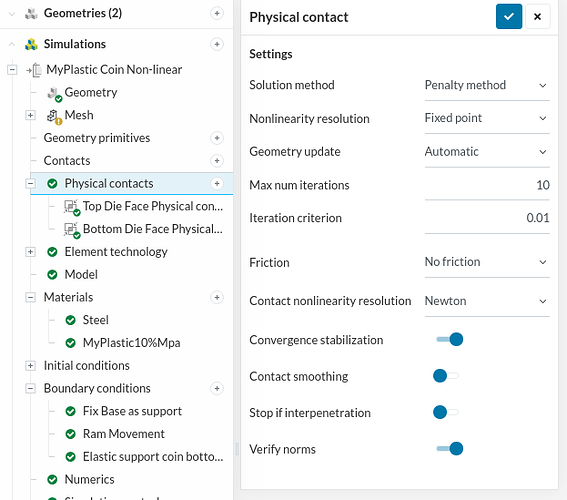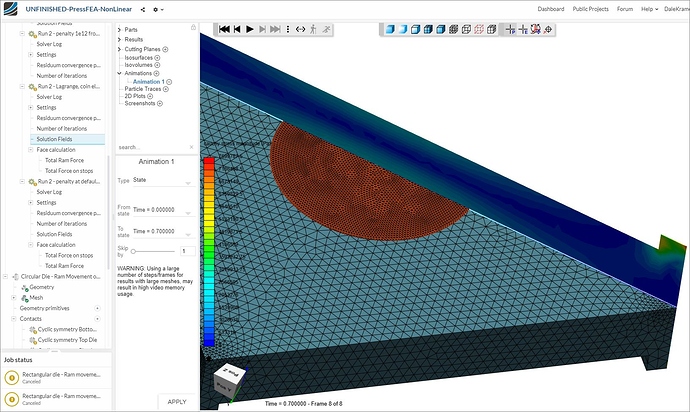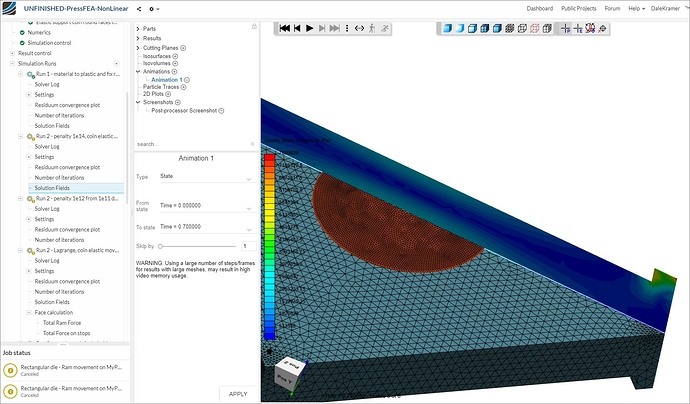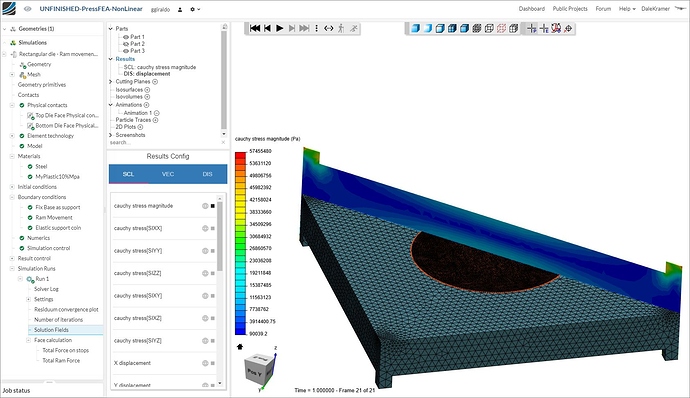@DaleKramer,
regarding the run for the full model, I think the scale of the movement is too large. You seem to want to apply a 12mm movement, but the coin seems only 1.2mm thick?
Regarding the cyclic symmetry: the setup is unfortunately not so straight-forward. Your system is basically over-constraint. The slave nodes of the cyclic symmetry condition are tied in normal direction already to the master elements on the opposite side. If you add a fixed value constraint on top there, you need to leave the normal direction free, otherwise you would constrain them twice. I can set up a working model later, but have no time at the moment. Please also make sure that the master and slave faces are correctly assigned based on the direction of the axis of rotation. You might find some useful information here: Contacts & Interfaces in Solid Mechanics and CHT | SimScale.
Best,
Richard
1 Like
Sorry for magnitude of steps for ram movement error, another fumble I will blame on the late night project  I should have seen that but just I’m learning formulas etc for movements etc…
I should have seen that but just I’m learning formulas etc for movements etc…
Will do on the cyclic symmetry, thanks for suggestions and link 
Hi @DaleKramer,
I changed the loading error and your model ran and converged for about .25 of the total time. Do you have any nonlinear material properties for the plastic your using? This may be part of the problem of why it cannot converge once is compressed the dist too much.
Christopher
3 Likes
Yes, I too just saw that my ‘MyPlastic10%Mpa’ had reverted to linear elastic, I know I had it as plastic with a table. Not sure hoe the table was lost and behaviour changed???
I will put them back to plastic with table now… Thanks…
EDIT 1: Fixed that now but not too sure if I have a good stress/strain curve yet (I am making some assumptions of my plastic at high temperature)
EDIT 2: Ok finally got some action on my full model, this animation shows coin expanding but nowhere’s near big enough, it should go out to almost the corner triangle squeeze depth stop, here is pic  :
:
I likely need to play with my stress/strain curve… I’ll do that after I get the low overhead Cyclic symmetry version working 
HOWEVER, still have unknown issues with the Cyclic symmetry version , any ideas 
@rszoeke In the Documentation link you provided I found this quote WRT cyclic symmetry condition:
" This is a linear constraint, so no large rotations or large deformations are allowed in the proximity of cyclic symmetry boundaries. "
Would this not seem to say I likely should not use Cyclic symmetry since my plastic coin deforms along a boundary of all my Cyclic symmetry contacts 
Hey Dale,
We can keep everything tidy and organized by keeping it in one place 
So my edit method is OK then (even after there are replies to a post I am editing) 
Hi @DaleKramer,
I am not sure what’s happening yet, but if you look at the mesh of the disk at the last time step, you can see the elements around the edge are elongated and growing the disk. The elements in the middle have not changed shape so the are not squishing correctly. This explains why your not seeing the larger change of shape you are expecting.
I’ll keep looking into it. I do know once you start deforming the elements too much the accuracy will go down and the convergence will be more difficult but I don’t think that is the problem yet.
Christopher
2 Likes
WOW, I will gratefully accept your help on this  , I am such an FEA newbie, but I try
, I am such an FEA newbie, but I try 
Sure. If the threads are longer you can also note in the recent posts that edits have been made - that’s up to you 
1 Like
Sorry, I just had to post this 
Crêpes go to the #cooking section of our Slack channel Dale! 
1 Like
Nice that you made some significant progress @DaleKramer!
As you added an elastic support to the lower surface of the coin, it actually does not deform symmetrically and the lower surface remains almost undeformed. I would probably use either both surfaces or the side face - btw. you can also use an orthotropic elastic support stiffness, and for example put a close to zero value in normal direction.
Wrt the small deformation limitation I would say in your case it should be fine as the normals of the cyclic symmetry plane do not change.
Your coin is also smaller than expected as you got some (relative to the final thickness) large contact penetration. You can try to increase the penalty factor or switch to a lagrangian contact to reduce the contact penetration.
Best,
Richard
1 Like
I do not see Lagrangien options for contact type in the new WB.
Nothing in Numerics either…
I don’t see in any Documentation how to select a Lagrangien contact, I would like to try it…
I did see this but not sure what it means:
The contact solution method has to be chosen in a global sense in a simulation setup. Of course you can define different properties for different contact pairs, but it is not possible to switch between for example penalty and lagrangian contact.
Hi @DaleKramer,
you can change the global physical contact settings in the parent tree node for the physical contacts:
At “Solution method” you can change between “Penalty Method” and “Augmented Lagrangian method”.
The comment you cited means that this setting can only be changed globally for all contact pairs and not individually per contact - so all contacts are either defined as Penalty or Lagrangian.
Good news: we will actually remove this restriction in the next 2 weeks. Then you can select this setting for each contact individually.
Best,
Richard
2 Likes
Theoretically, we should see this coin diameter at 1.0s (from CAD program):
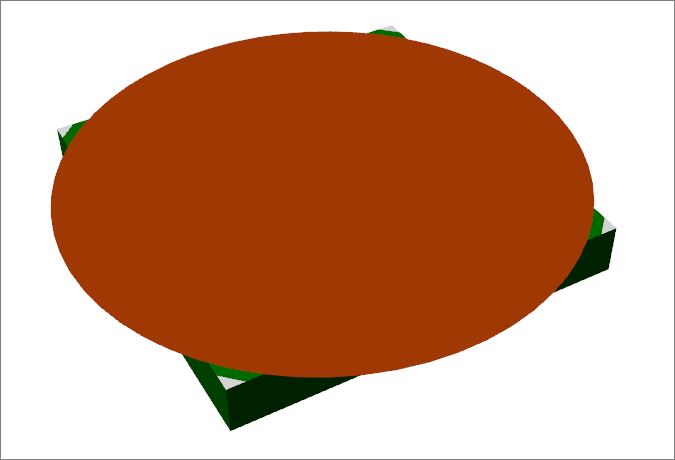
And the horses are coming around the bend, with Lagrange at 0.8s just a hair ahead of Penalty1e14 at 0.8s.
But wait all the horses have stopped and it looks like none of them can get past that critical 0.8s to the 1.0s finish 
Here is as far as Lagrange got:
And here is how far Penalty1e14 got:
Hey, race fans, any idea why the last 4 horses have slowed to a snails pace at about 0.8s after a quick ~15 core hours to get there and then sim had to be cancelled after ~60 core hours after no further progress and no errors in solver logs 
I made a copy of the project and was able to simulate the whole displacement.
Here is the link: SimScale
Some changes I made:
- Applied the elastic constraint to the cylindrical face of the coin, with an isotropic value of 1000 (N/m) this is arbitrary and works, but is generating 1 N of force en each node for each 1 mm of displacement, what should be taken into account when analyzing results.
- Turned some numerical knobs, the most important being lowering the tolerance to around 0.0001, lowering initial time step to 0.05, number of processors to 16.
I think the following step is to implement a hyperelastic material model, or whatever is closes to the material being used. Please evaluate if results are satisfactory.
2 Likes
Great advice on the numerics 
EDIT: But I think see that the Numerics changes you made to my 'Run 2 - penalty … ’ were:
- ‘Tolerance’ from its 0.000001 default to 0.0004 (you say this may be the most significant change that allowed completion)
- ‘Max Newton iterations’ from its default of 15 to 20
And changes to the Simulation control were:
- ‘Initial time step’ from default 0.1 to 0.05
- ‘Number of subdivisions’ from default 2 to 4
- ‘Number of processors’ from 32 to 16 (which forces ‘Number of parallel processes’ to change from 16 to 8)
Am I correct on this, if so perhaps edit your post for those that follow.
The two leaders so far had elastic on coin cylindrical face, but it is good to know you had to increase the elastic stiffness to 1000 N/m for your success…
AND, ggiraldoRun1, using modified parametesr of penalty1e14 , appears out of nowhere, with a horse that does not die in the diameter race, to take a slight lead and the pack is just coming around the bend 
The race to the finish seems to be a matter of changing the state of matter in the lead horse 
I am on it 
At this point I am not too concerned that I match my exact material properties until we get something running to full diameter, so anyone can still join the race here … 
1 Like
 I should have seen that but just I’m learning formulas etc for movements etc…
I should have seen that but just I’m learning formulas etc for movements etc…
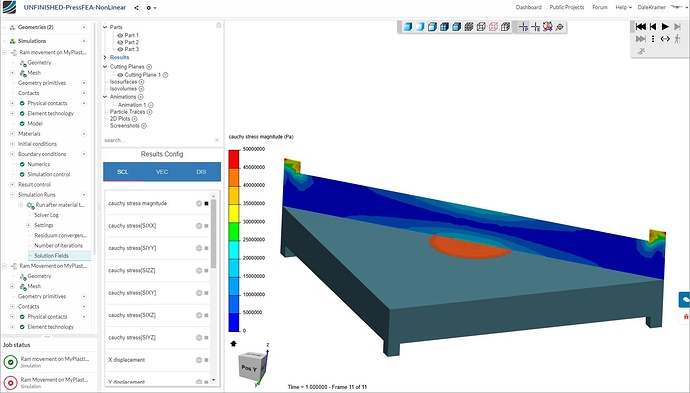

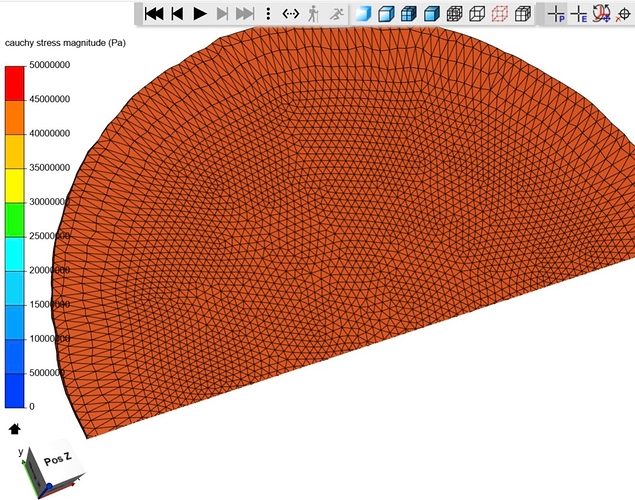
 , I am such an FEA newbie, but I try
, I am such an FEA newbie, but I try 